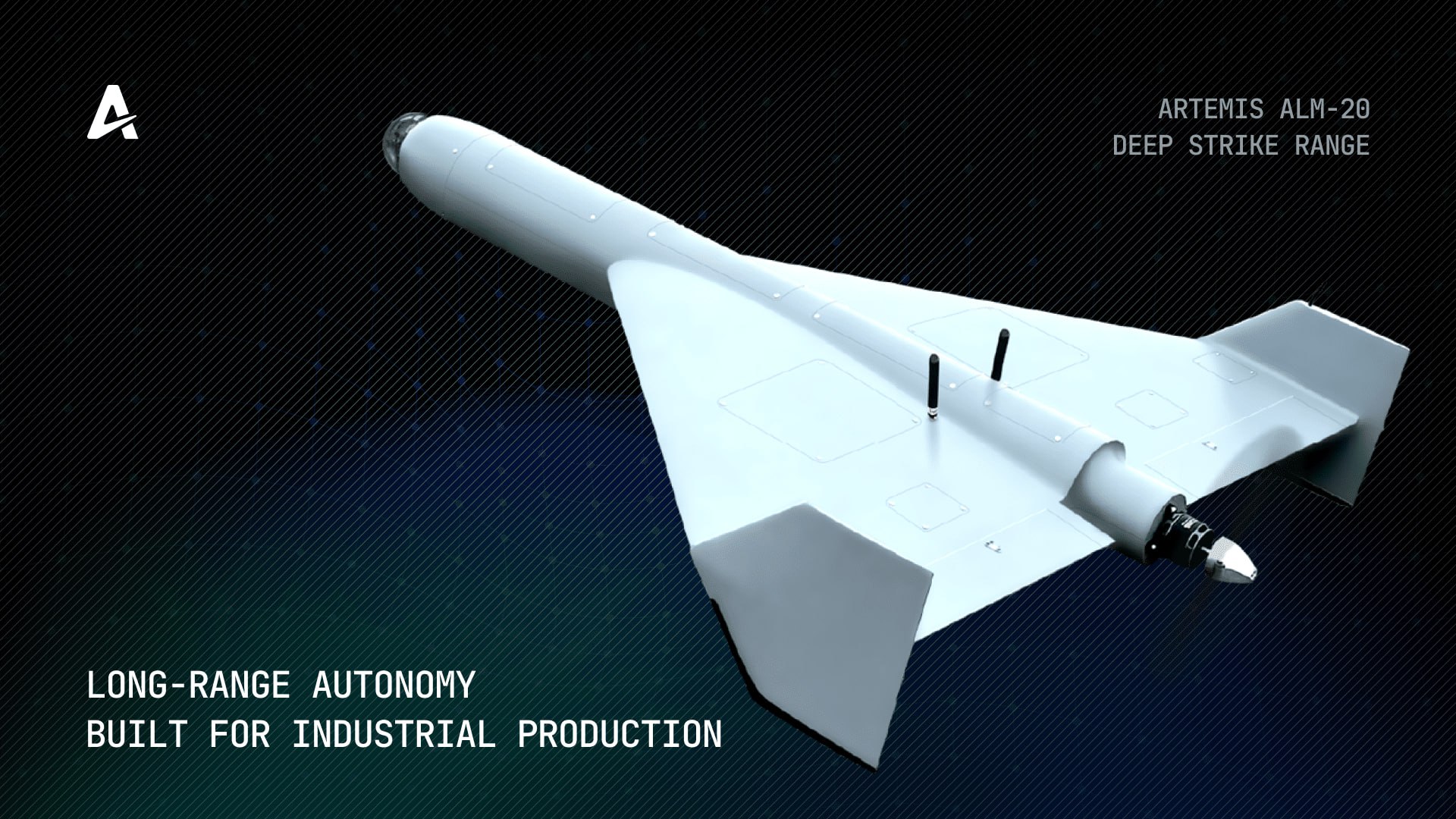The Shahed series of drones deployed extensively by Russia to strike Ukraine has proven so effective that both Kiev and Washington are now seeking analogs of the notorious drone.
An American company, named Auterion, collaborated with an unnamed Ukrainian company to develop a drone to mirror the capabilities of the Shahed-136—the Iranian-origin kamikaze drone used by Russia under the name ‘Geran-2,’ as reported by Defense Express and other local Ukrainian media outlets.
The drone, named ‘Artemis ALM-20’, is reportedly a deep-strike kamikaze drone with Artificial Intelligence (AI) and self-guidance under the Artemis project. Auterion, for one, specialises in developing software for Unmanned Aerial Vehicles (UAVs).
The ALM-20 has a reported range of 1,600 kilometres and a combat weight of 45 kilograms. It features a visual targeting system using artificial intelligence algorithms.
The aerodynamic shape of the ALM-20 resembles the Shahed‑136. It features a nose-mounted camera, extra antennas, and an electric motor—a rather unusual option for long-range drones, according to experts.
The report stated that the ALM-20 has already undergone extensive testing, which “included ground launch, GPS and GPS‑denied navigation, long-range transit, and terminal engagement.” The report further stated that the navigation and guidance system has been integrated into a series of other ALM-20 drones with different operational ranges.
A new American–Ukrainian long-range kamikaze drone, the Artemis ALM-20, reportedly completed successful tests over Russian territory and is now moving toward mass production across Ukraine, the U.S., and Germany.
Developed by Auterion (a U.S. UAV software company) with an… pic.twitter.com/NSe08QBIfv
— Clash Report (@clashreport) October 16, 2025
The American company is prioritising the long-range variant for mass production—a move aligned with Ukraine’s latest strategy of attacking crucial infrastructure and military facilities deep inside the Russian territory.
The embattled country has been pleading for long-range missiles, such as the American Tomahawk and the German Taurus, to achieve that goal. The introduction of long-range drones presents a more feasible and cost-effective long-strike capability.
The company reportedly stated it is moving into the scale-up phase with the Department of War and allies to work towards co-production at a mass scale. Production lines are being laid in Germany, the US, and Ukraine.
It is worth noting that a smaller variant of a Shahed-like drone was unveiled in the past. In December 2024, Ukraine unveiled a strike drone resembling a smaller version of the Iranian Shahed drone during a visit by German Chancellor Olaf Scholz to the country.
Even though specific details were withheld, analysts assessed that the drone was equipped with an electric motor, antennas for communication with the operator, and a fixed video sensor. The combat use of these drones was first recorded in March this year.
The development of a Shahed analog appears to be a joint US-Ukraine attempt at beating Russia at its own game. The Russian military has extensively deployed these drones to target Ukraine’s civilian and military infrastructure ro criiple the country.
A report published in The Economist in May 2025 claimed that Russia is producing about 100 Shaheds per day and aims to further boost the capacity to 500 per day this year.

The Shahed-136 drone operates autonomously, meaning it does not require real-time human control after launch. It relies on basic waypoint navigation, but remains vulnerable to electronic warfare (EW) techniques like GPS spoofing or jamming.
Russia has also given six upgrades to newly produced Shahed drones and has been relentlessly working to enhance the targeting and navigation modules.
The Ukrainian engineers claimed earlier this year that since the latest Shahed variants no longer rely on GPS, they have become impervious to Ukraine’s electronic warfare capabilities.
Instead, they have found a way to leverage AI and Ukraine’s mobile internet networks. Some reports stated that these drones were now being guided by Telegram bots that provide human operators with real-time flight data and video feed.
Russia has intensified its aerial assaults on Ukraine, which means that there has been a surge in Shaheds flying into the embattled cities in recent times.
Earlier this week, Polish Foreign Minister Radosław Sikorski paraded a Shahed drone captured in combat in the UK Parliament Building.
Zgadzam się z Prezydentem Trumpem, że bez uderzenia w terytorium wroga, nie da się wygrać wojny, dlatego Tomahawki powinny trafić do Ukrainy.
📺 Londyn, wywiad dla @Channel4News pic.twitter.com/gPm6eykPg4
— Radosław Sikorski 🇵🇱🇪🇺 (@sikorskiradek) October 15, 2025
“Today in the British Parliament, I demonstrated the Iranian Shahed 136 drone, which Russia has used against Ukraine. The Kremlin uses such drones to terrorize Ukrainians, and with decoys, it even entered Polish airspace,” he wrote on social media site X. He emphasized that an entire fleet of such scrap metal could destroy critical infrastructure.
The Surging Popularity Of Shahed
The Shahed-136 drones have caught the attention of the US, with growing clamour for the development and production of Shahed-like kamikaze drones across the military.
In August 2025, the US Air Force (USAF) asked the industry to produce identical copies of the Shahed-136 drone to develop and test defenses against the Iranian-designed system.
The USAF wants to buy 16 of these Shahed-136 lookalikes, with the option to buy 20 more at a later stage, to test the ‘next-generation’ of its counter-drone systems against these threats, as per a Request for Information (RFI) posted at the time.
“The United States Government (USG) intends to purchase approximately 16 counter-Unmanned Aerial System (cUAS) drones to support the next generation of cUAS weapons program development and integration. To support weapons development and integration of these weapon systems, the USG requires that the Class 3 Unmanned Aerial Target System be a 1:1 copy (form, fit, and function) of a reverse-engineered Shahed-136 suicide drone,” the solicitation read, as earlier reported by the EurAsian Times.
“This acquisition aims to leverage drones representative of the Shahed-136, which is currently used by adversarial countries and is being encountered in multiple areas of operation,” it added.
It is pertinent to note that USAF RFI stated that the Iranian Shahed-136 drones are “utilized by the Russians in Ukraine,” are “difficult to detect, fly low, and descend to one hundred meters before hitting the target.”
Furthermore, the RFI said that the drone must be a replica of the Iranian drone, a 1:1 copy (reverse engineered) of the Shahed 136 suicide drone.
“It needs to meet the form, fit, and function of the Shahed 136 currently being developed and used by Iran. This is to include – Rear-facing propeller with the same size and position characteristics as the Shahed-136, Same Shape/profile, and Same payload capacity.”
Thus, reiterating the operational utility and prowess of the Shahed design.
- Contact the author at sakshi.tiwari13 (at) outlook.com
- Follow EurAsian Times on Google News




